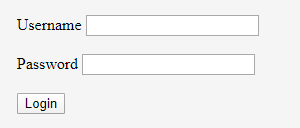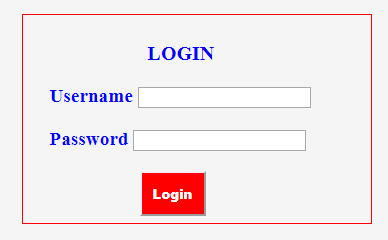PHP Login Template
In this article, we will learn about PHP Login Template. The moment we talk about a web application, we need to have a login page to get access to it. This is one of the basic requirements to have the login page. The Login Page is one of the required pages where there is restricted access in any web application. Most of the login page comes up with the two fields only. Usually, the username is considered the first field and the second one will be the password one. There is no fixed opinion for the login page template. We can go with any login page template as per our business requirements.
ADVERTISEMENT Popular Course in this category PHP DEVELOPER - Specialization | 8 Course Series | 3 Mock TestsStart Your Free Software Development Course
Web development, programming languages, Software testing & others
Syntax:
As per the syntax of the login page is concerned, there is no thumb rule to follow while working for the login page design. In this article, we will see a few examples of the login template. If we ask 5 people to come up with a login page template or the design, they could come up with 5 different as there are no industry standards as per its look and feel is concerned. So, in the coming sections, we will see the progressive view of the login page template and how we can create this page as well.
How does it work?
Any login page in the PHP is not possible by using the PHP only. A template of the PHP Login combines the various other technology like JavaScript, HTML, CSS, MySql database, etc. Now, let’s see the role of each entity one by one.
HTML: HTML is one of the basic building blocks of any web page of the application. The required of the login page will be written in this HTML only.
Code:
<!DOCTYPE html> <html> <head> <title>Page Title</title> </head> <body style="margin-left: 20%; margin: 5%;"> <form method="post" action="" name="login_form"> <div class="form-element"> <label>Username</label> <input type="text" name="username" id="username" required /> </div> <br> <div class="form-element"> <label>Password</label> <input type="password" name="password" id="password" required /> </div> <br> <button type="submit" name="Login" value="Login">Login</button> </form> </body> </html>
Output:

We can see, the look and the UI of this page is not professional enough we can move ahead with.
- CSS: CSS is again the very basic need in the web application. We can use this CSS to beautify our login page. We have various options available in the CSS we can use to put a professional look of the above login page. We can use the background color of the form. We can use the border of the form and various other related things.
- JavaScript/jQuery: A JavaScript is one of the scripts we can use for the client-side validation. We can use JavaScript to display the error message as per our business needs. For example, we can stop the form submission if any of the fields (either username or password or both) is not filled. This is again a value-added if we use JavaScript or jQuery in while coding for the login page.
All the above mentioned is good enough for designing a login page. But if we want to process with the complete login then we need to have the PHP and a Database (MYSQL or any other) as well.
Examples to Implement PHP Login Template
Now, it’s time to see various login page examples. We are moving ahead with the same HTML code mentioned above. We will see various templates using the above code or making a bit of modification in the above code.
Example #1
Code:
<!DOCTYPE html>
<html>
<head>
<title>Page Title</title>
</head>
<body>
<form method="post" action="" name="login_form" id="login_form">
<div class="form-element">
<label class="head">Login </label>
</div>
<div class="form-element">
<label>Username</label>
<input type="text" name="username" id="username" required />
</div>
<div class="form-element">
<label>Password</label>
<input type="password" name="password" id="password" required />
</div>
<button type="submit" id="Login" name="Login" value="Login">Login</button>
</form>
</body>
<style>
body{margin-left: 30%; margin-top: 5%; max-width: 350px;}
.head {
margin-left: 98px;
font-size: 20px;
font-weight: 900;
text-transform: uppercase;
}
#login_form{
color: blue;
font-size: larger;
border: 1px solid red;
padding: 7px;
}
.form-element{margin: 20px;}
#Login{
font-weight: 900;
background: red;
margin-left: 110px;
padding: 11px;
color: #fff;
}
label{font-weight: 900;}
</style>
</html>Output:

Example #2
In this login page template, we will see the more interactive as compared to the previous one. We will be using some more advanced CSS.
Code:
<!DOCTYPE html>
<html>
<head>
<title>Login Page</title>
</head>
<body>
<h4>Welcome to the Website!</h4>
<form method="post" action="" name="login_form" id="login_form">
<div class="form-element">
<label class="head">Login </label>
</div>
<div class="form-element">
<label>Username</label>
<input type="text" name="username" id="username" required />
</div>
<div class="form-element">
<label>Password</label>
<input type="password" name="password" id="password" required />
</div>
<button type="submit" id="Login" name="Login" value="Login">Login</button>
</form>
</body>
<style>
body{
margin-left: 30%;
margin-top: 5%;
max-width: 350px;
background: #c0c078;
}
.head {
margin-left: 98px;
font-size: 20px;
font-weight: 900;
text-transform: uppercase;
}
#login_form{
font-size: larger;
border: 1px dotted #3406ed;
padding: 10px;
}
.form-element{margin: 20px;}
#Login{
font-weight: 900;
margin-left: 132px;
padding: 7px;
color: red;
}
label{font-weight: 900;}
h4{text-align: center; text-decoration: underline;}
</style>
</html>Output:

Example #3
In this example, we will see the different than the above two Login page layout.
Code:
<!DOCTYPE html>
<html>
<head>
<title>Login Page</title>
</head>
<body>
<form method="post" action="" name="login_form" id="login_form">
<div class="form-element">
<h2>Welcome </h2>
<input type="text" name="username" id="username" placeholder="Username" required />
<input type="password" name="password" id="password" placeholder="Password" required />
<input type="submit" id="submit" value="Let me in" />
</div>
</form>
</body>
<style>
html{
width: 100%;
height: 100%;
overflow: hidden;
}
body {
width: 100%;
height:100%;
background: #465151;
}
h2{
color: #fff;
text-shadow: 0 0 10px rgba(0,0,0,0.3);
letter-spacing: 1px;
text-align: center;
}
input {
width: 100%;
line-height: 4;
margin-bottom: 10px;
background: rgba(0,0,0,0.3);
border: none;
outline: none;
font-size: 13px;
color: #fff;
text-shadow: 1px 1px 1px rgba(0,0,0,0.3);
border: 1px solid rgba(0,0,0,0.3);
border-radius: 4px;
box-shadow: inset 0 -5px 45px rgba(100,100,100,0.2), 0 1px 1px rgba(255,255,255,0.2);
-webkit-transition: box-shadow .5s ease;
-moz-transition: box-shadow .5s ease;
-o-transition: box-shadow .5s ease;
-ms-transition: box-shadow .5s ease;
transition: box-shadow .5s ease;
}
#submit{
background-color: #4a77d4;
padding: 25px 14px;
font-size: 15px;
line-height: normal
}
form#login_form {
width: 30%;
margin-left: 30%;
margin-top:100px;
}
::placeholder {
color:#fff;
font-size: 18px;
padding-left: 20px;
}
</style>
</html>Output:

Conclusion
PHP Login page is one of the required things in this era of the digital revolution. Since there is not any standard of making the login page template, so we can move ahead of any template as per our business requirements. It is always advisable to use the client-side validation before posting any login page request to the server.
The above is the detailed content of PHP Login Template. For more information, please follow other related articles on the PHP Chinese website!

Hot AI Tools

Undresser.AI Undress
AI-powered app for creating realistic nude photos

AI Clothes Remover
Online AI tool for removing clothes from photos.

Undress AI Tool
Undress images for free

Clothoff.io
AI clothes remover

AI Hentai Generator
Generate AI Hentai for free.

Hot Article

Hot Tools

Notepad++7.3.1
Easy-to-use and free code editor

SublimeText3 Chinese version
Chinese version, very easy to use

Zend Studio 13.0.1
Powerful PHP integrated development environment

Dreamweaver CS6
Visual web development tools

SublimeText3 Mac version
God-level code editing software (SublimeText3)

Hot Topics
 1382
1382
 52
52
 PHP 8.4 Installation and Upgrade guide for Ubuntu and Debian
Dec 24, 2024 pm 04:42 PM
PHP 8.4 Installation and Upgrade guide for Ubuntu and Debian
Dec 24, 2024 pm 04:42 PM
PHP 8.4 brings several new features, security improvements, and performance improvements with healthy amounts of feature deprecations and removals. This guide explains how to install PHP 8.4 or upgrade to PHP 8.4 on Ubuntu, Debian, or their derivati
 How To Set Up Visual Studio Code (VS Code) for PHP Development
Dec 20, 2024 am 11:31 AM
How To Set Up Visual Studio Code (VS Code) for PHP Development
Dec 20, 2024 am 11:31 AM
Visual Studio Code, also known as VS Code, is a free source code editor — or integrated development environment (IDE) — available for all major operating systems. With a large collection of extensions for many programming languages, VS Code can be c
 7 PHP Functions I Regret I Didn't Know Before
Nov 13, 2024 am 09:42 AM
7 PHP Functions I Regret I Didn't Know Before
Nov 13, 2024 am 09:42 AM
If you are an experienced PHP developer, you might have the feeling that you’ve been there and done that already.You have developed a significant number of applications, debugged millions of lines of code, and tweaked a bunch of scripts to achieve op
 How do you parse and process HTML/XML in PHP?
Feb 07, 2025 am 11:57 AM
How do you parse and process HTML/XML in PHP?
Feb 07, 2025 am 11:57 AM
This tutorial demonstrates how to efficiently process XML documents using PHP. XML (eXtensible Markup Language) is a versatile text-based markup language designed for both human readability and machine parsing. It's commonly used for data storage an
 Explain JSON Web Tokens (JWT) and their use case in PHP APIs.
Apr 05, 2025 am 12:04 AM
Explain JSON Web Tokens (JWT) and their use case in PHP APIs.
Apr 05, 2025 am 12:04 AM
JWT is an open standard based on JSON, used to securely transmit information between parties, mainly for identity authentication and information exchange. 1. JWT consists of three parts: Header, Payload and Signature. 2. The working principle of JWT includes three steps: generating JWT, verifying JWT and parsing Payload. 3. When using JWT for authentication in PHP, JWT can be generated and verified, and user role and permission information can be included in advanced usage. 4. Common errors include signature verification failure, token expiration, and payload oversized. Debugging skills include using debugging tools and logging. 5. Performance optimization and best practices include using appropriate signature algorithms, setting validity periods reasonably,
 PHP Program to Count Vowels in a String
Feb 07, 2025 pm 12:12 PM
PHP Program to Count Vowels in a String
Feb 07, 2025 pm 12:12 PM
A string is a sequence of characters, including letters, numbers, and symbols. This tutorial will learn how to calculate the number of vowels in a given string in PHP using different methods. The vowels in English are a, e, i, o, u, and they can be uppercase or lowercase. What is a vowel? Vowels are alphabetic characters that represent a specific pronunciation. There are five vowels in English, including uppercase and lowercase: a, e, i, o, u Example 1 Input: String = "Tutorialspoint" Output: 6 explain The vowels in the string "Tutorialspoint" are u, o, i, a, o, i. There are 6 yuan in total
 Explain late static binding in PHP (static::).
Apr 03, 2025 am 12:04 AM
Explain late static binding in PHP (static::).
Apr 03, 2025 am 12:04 AM
Static binding (static::) implements late static binding (LSB) in PHP, allowing calling classes to be referenced in static contexts rather than defining classes. 1) The parsing process is performed at runtime, 2) Look up the call class in the inheritance relationship, 3) It may bring performance overhead.
 What are PHP magic methods (__construct, __destruct, __call, __get, __set, etc.) and provide use cases?
Apr 03, 2025 am 12:03 AM
What are PHP magic methods (__construct, __destruct, __call, __get, __set, etc.) and provide use cases?
Apr 03, 2025 am 12:03 AM
What are the magic methods of PHP? PHP's magic methods include: 1.\_\_construct, used to initialize objects; 2.\_\_destruct, used to clean up resources; 3.\_\_call, handle non-existent method calls; 4.\_\_get, implement dynamic attribute access; 5.\_\_set, implement dynamic attribute settings. These methods are automatically called in certain situations, improving code flexibility and efficiency.




